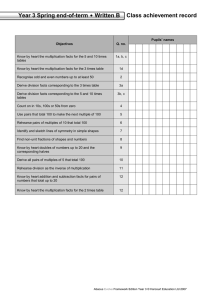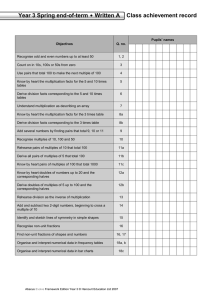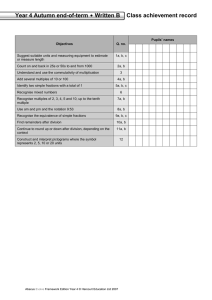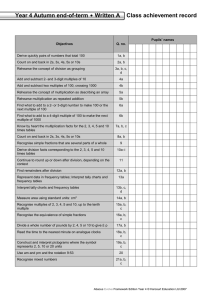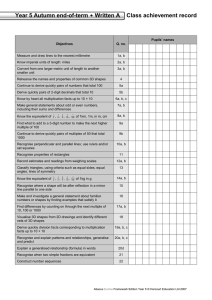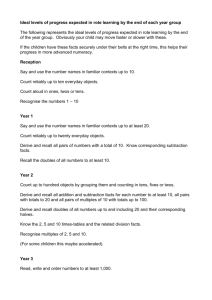Mathsworks Yearly Plans Year 3 Block E (DOC, 80 KB)
advertisement
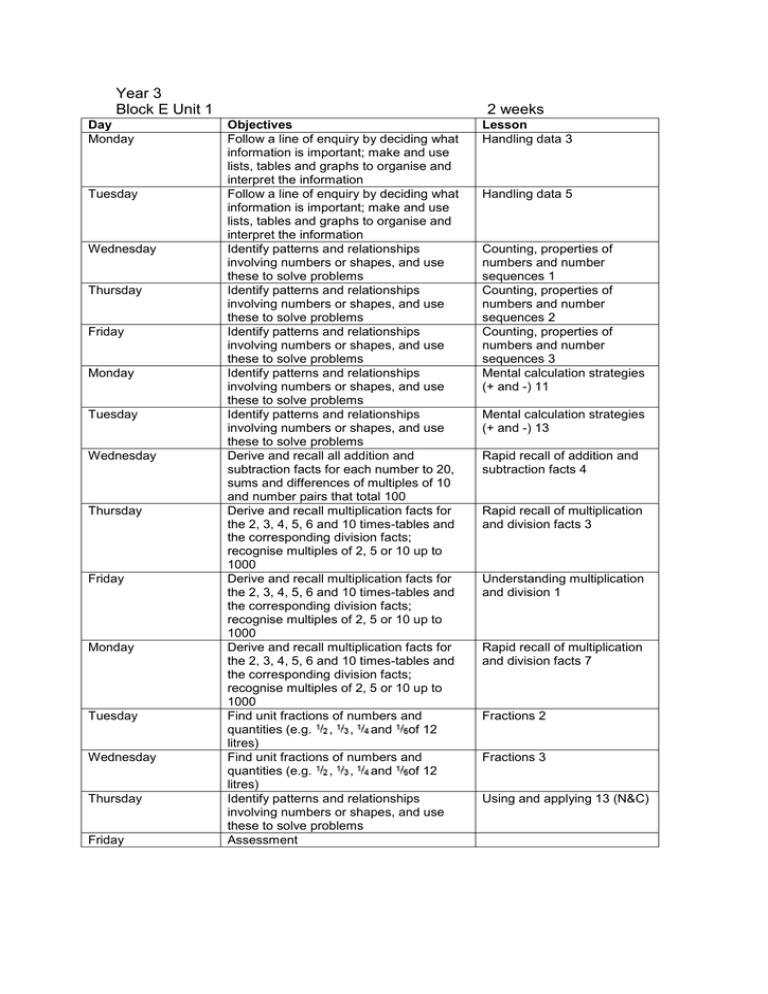
Year 3 Block E Unit 1 Day Monday Tuesday Wednesday Thursday Friday Monday Tuesday Wednesday Thursday Friday Monday Tuesday Wednesday Thursday Friday 2 weeks Objectives Follow a line of enquiry by deciding what information is important; make and use lists, tables and graphs to organise and interpret the information Follow a line of enquiry by deciding what information is important; make and use lists, tables and graphs to organise and interpret the information Identify patterns and relationships involving numbers or shapes, and use these to solve problems Identify patterns and relationships involving numbers or shapes, and use these to solve problems Identify patterns and relationships involving numbers or shapes, and use these to solve problems Identify patterns and relationships involving numbers or shapes, and use these to solve problems Identify patterns and relationships involving numbers or shapes, and use these to solve problems Derive and recall all addition and subtraction facts for each number to 20, sums and differences of multiples of 10 and number pairs that total 100 Derive and recall multiplication facts for the 2, 3, 4, 5, 6 and 10 times-tables and the corresponding division facts; recognise multiples of 2, 5 or 10 up to 1000 Derive and recall multiplication facts for the 2, 3, 4, 5, 6 and 10 times-tables and the corresponding division facts; recognise multiples of 2, 5 or 10 up to 1000 Derive and recall multiplication facts for the 2, 3, 4, 5, 6 and 10 times-tables and the corresponding division facts; recognise multiples of 2, 5 or 10 up to 1000 Find unit fractions of numbers and quantities (e.g. , , and of 12 litres) Find unit fractions of numbers and quantities (e.g. , , and of 12 litres) Identify patterns and relationships involving numbers or shapes, and use these to solve problems Assessment Lesson Handling data 3 Handling data 5 Counting, properties of numbers and number sequences 1 Counting, properties of numbers and number sequences 2 Counting, properties of numbers and number sequences 3 Mental calculation strategies (+ and -) 11 Mental calculation strategies (+ and -) 13 Rapid recall of addition and subtraction facts 4 Rapid recall of multiplication and division facts 3 Understanding multiplication and division 1 Rapid recall of multiplication and division facts 7 Fractions 2 Fractions 3 Using and applying 13 (N&C) Block E Unit 2 Day Monday Tuesday Wednesday Thursday Friday Monday Tuesday Wednesday Thursday Friday Monday 2 weeks Objectives Identify patterns and relationships involving numbers or shapes, and use these to solve problems Identify patterns and relationships involving numbers or shapes, and use these to solve problems Derive and recall multiplication facts for the 2, 3, 4, 5, 6 and 10 times-tables and the corresponding division facts; recognise multiples of 2, 5 or 10 up to 1000 Identify patterns and relationships involving numbers or shapes, and use these to solve problems Derive and recall multiplication facts for the 2, 3, 4, 5, 6 and 10 times-tables and the corresponding division facts; recognise multiples of 2, 5 or 10 up to 1000 Derive and recall multiplication facts for the 2, 3, 4, 5, 6 and 10 times-tables and the corresponding division facts; recognise multiples of 2, 5 or 10 up to 1000 Derive and recall multiplication facts for the 2, 3, 4, 5, 6 and 10 times-tables and the corresponding division facts; recognise multiples of 2, 5 or 10 up to 1000 Derive and recall multiplication facts for the 2, 3, 4, 5, 6 and 10 times-tables and the corresponding division facts; recognise multiples of 2, 5 or 10 up to 1000 Multiply one-digit and two-digit numbers by 10 or 100, and describe the effect Use practical and informal written methods to multiply and divide two-digit numbers (e.g. 13 3, 50 4); round remainders up or down, depending on the context Use practical and informal written methods to multiply and divide two-digit numbers (e.g. 13 3, 50 4); round remainders up or down, depending on the context Understand that division is the inverse of multiplication and vice versa; use this to derive and record related multiplication and division number sentences Use practical and informal written methods to multiply and divide two-digit numbers (e.g. 13 3, 50 4); round remainders up or down, depending on the context Understand that division is the inverse of Lesson Using and applying 9 (N&C) Using and applying 10 (N&C) Counting, properties of numbers and number sequences 7 Counting, properties of numbers and number sequences 9 Mental calculation strategies ( and ) 7 Understanding multiplication and division 2 Understanding multiplication and division 3 Rapid recall of multiplication and division facts 6 Mental calculation strategies ( and ) 1 Mental calculation strategies ( and ) 5 Mental calculation strategies ( and ) 6 Tuesday Wednesday Thursday Friday multiplication and vice versa; use this to derive and record related multiplication and division number sentences Read and write proper fractions (e.g. , ), interpreting the denominator as the parts of a whole and the numerator as the number of parts; identify and estimate fractions of shapes; use diagrams to compare fractions and establish equivalents Find unit fractions of numbers and quantities (e.g. , , and of 12 litres) Identify patterns and relationships involving numbers or shapes, and use these to solve problems Solve one-step and two-step problems involving numbers, money or measures, including time, choosing and carrying out appropriate calculations Assessment Block E Unit 3 Day Monday Tuesday Wednesday Thursday Friday Monday Tuesday Wednesday Thursday Friday Fractions 5 Using and applying 15 (N&C) Using and applying 20 (N&C) 2 weeks Objectives Follow a line of enquiry by deciding what information is important; make and use lists, tables and graphs to organise and interpret the information Partition three-digit numbers into multiples of 100, 10 and 1 in different way Partition three-digit numbers into multiples of 100, 10 and 1 in different way Partition three-digit numbers into multiples of 100, 10 and 1 in different way Identify patterns and relationships involving numbers or shapes, and use these to solve problems Identify patterns and relationships involving numbers or shapes, and use these to solve problems Solve one-step and two-step problems involving numbers, money or measures, including time, choosing and carrying out appropriate calculations Identify patterns and relationships involving numbers or shapes, and use these to solve problems Develop and use written methods to record, support or explain addition and subtraction of two-digit and three-digit numbers Derive and recall multiplication facts for the 2, 3, 4, 5, 6 and 10 times-tables and the corresponding division facts; recognise multiples of 2, 5 or 10 up to 1000 Derive and recall multiplication facts for the 2, 3, 4, 5, 6 and 10 times-tables and Lesson Handling data 12 Mental calculation strategies (+ and -) 9 Mental calculation strategies (+ and -) 10 Pencil and paper procedures 5 Mental calculation strategies (+ and -) 14 Mental calculation strategies (+ and -) 15 Mental calculation strategies (+ and -) 17 Paper and pencil procedures (+ and -) 4 Counting, properties of numbers and number sequences 6 Counting, properties of numbers and number Monday Tuesday Wednesday Thursday Friday the corresponding division facts; recognise multiples of 2, 5 or 10 up to 1000 Identify patterns and relationships involving numbers or shapes, and use these to solve problems Use practical and informal written methods to multiply and divide two-digit numbers (e.g. 13 3, 50 4); round remainders up or down, depending on the context Partition three-digit numbers into multiples of 100, 10 and 1 in different way Read and write proper fractions (e.g. , ), interpreting the denominator as the parts of a whole and the numerator as the number of parts; identify and estimate fractions of shapes; use diagrams to compare fractions and establish equivalents Find unit fractions of numbers and quantities (e.g. , , and of 12 litres) Find unit fractions of numbers and quantities (e.g. , , and of 12 litres) Solve one-step and two-step problems involving numbers, money or measures, including time, choosing and carrying out appropriate calculations Assessment sequences 8 Mental calculation strategies ( and ) 9 Fractions 6 Understanding multiplication and division 8 Using and applying 19 (N&C)
